Gemlike Sweet Black Soybeans called Kuromame are a classic dish for Osechi Ryori or traditional Japanese New Year foods. The shiny beans symbolize good health in the new year. Try my pressure cooker recipe to shorten cooking time without sacrificing flavor.
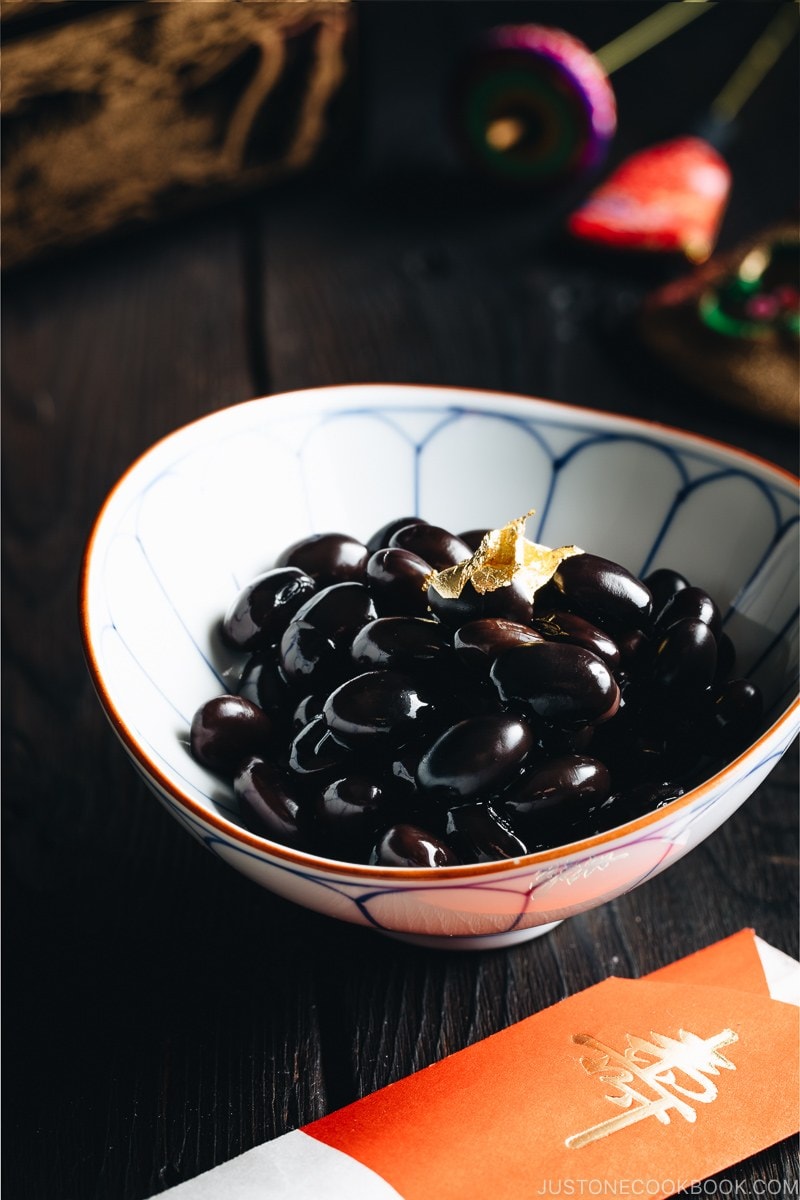
One of the easiest dishes you can make for the Japanese New Year (Oshogatsu) is Kuromame (黒豆) or sweet black soybeans. The soybeans are typically simmered on low heat over a long period of time in a syrup. To shorten the cooking process, we’ll cook the soybeans using a pressure cooker. This Instant Pot Kuromame will save you hours in the kitchen, so you can make one more dish for Osechi!
What is Kuromame?
Kuromame (黒豆) is literary black (黒) soybeans (豆) in Japanese. The soybeans are simmered in a sauce made of water, sugar, soy sauce, and salt, and then let soak for another day to yield a strikingly glossy and black appearance. They are delightfully sweet with just a tinge of savory flavor. It is one of the “sweet” side dishes served along with other savory osechi foods.
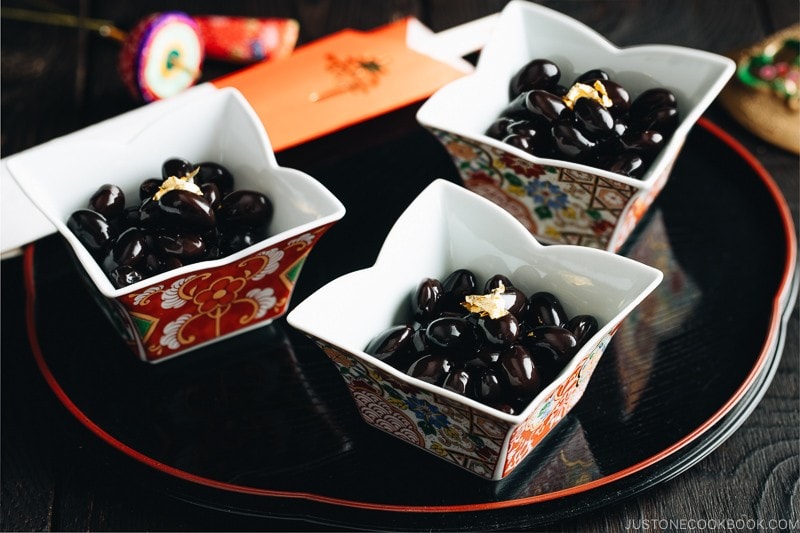
When making kuromame, we place a great focus on the color of the black soybeans. The shinier and more intensely black they are, the higher the praise. In addition to the color, it is also important that the skin of the soybeans is not wrinkled. Shiny, pearl-like black soybeans are a subtle yet important piece of osechi.
The Secret to Enhancing the Color of Black Soybeans
Dried beans need to be soaked before cooking. When you soak black soybeans in water, the water turns dark purplish and the beans lose their color and become brown or reddish. Once you simmer the beans in the same water, they will regain their black/black-ish color.
You may wonder how to make the black soybeans even MORE black. The answer is rusty iron nails. I know, I’m about to get some raised eyebrows…
Dubious it may sound, this technique has been passed down for generations. Why rusty nail? Well, the rust (iron oxide) from nails has a chemical reaction with anthocyanins (chemicals that are located in the skin of black beans), which makes the beans dark. What people do is to clean the nails and wrap in cheesecloth to soak with the beans.
Are there any cleaner and better “food-safety” alternative? Absolutely!
- Use a cast iron deep pot. A cast-iron skillet is a bit too shallow.
- Buy this Lucky Iron Fish® (not sponsored), which is available on Amazon.
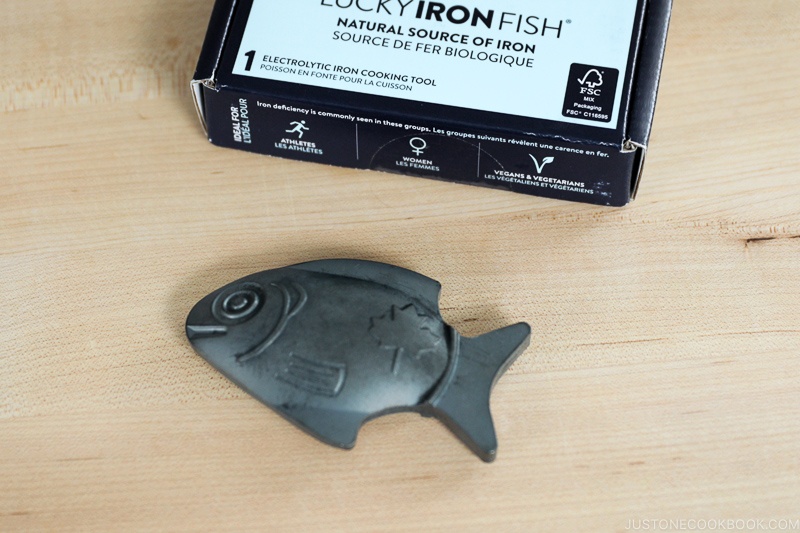
The Lucky Iron Fish is a small iron cooking tool that infuses your meals with a healthy amount of natural iron to help prevent iron deficiency and anemia. It’s especially perfect for athletes, vegetarians, vegans, women, and kuromame makers like us!
All you need to do is to soak the Lucky Iron Fish in the water along with the black soybeans.
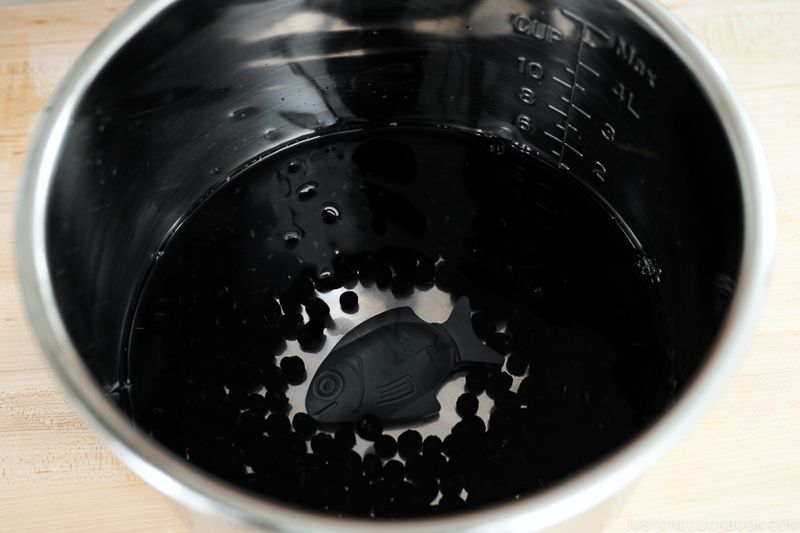
And after 4 hours of soaking, remove the iron fish (Update on 12/31/19: I kept the iron fish and pressure cook in the Instant Pot, and it was fine. I recommend leaving it in the pot.) Check out the color of the water. It turns completely black! Now you can proceed to cook the black soybeans.
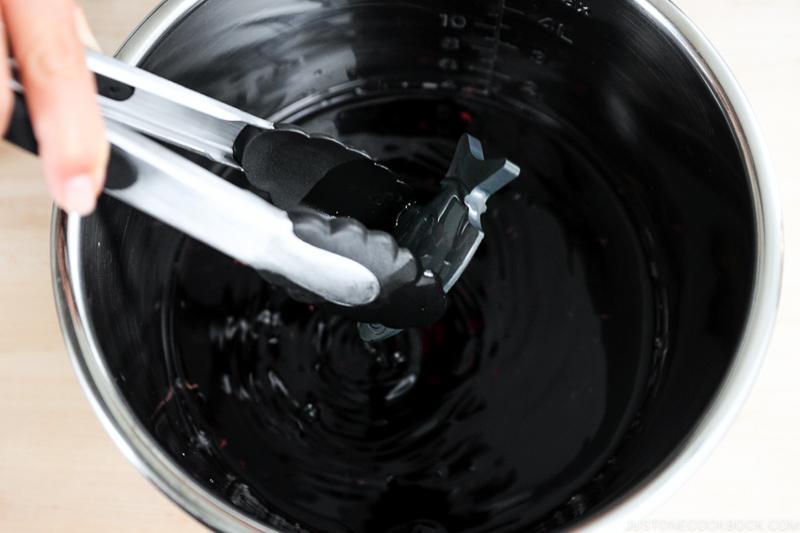
After pressure cooking, here is the final result of the kuromame.
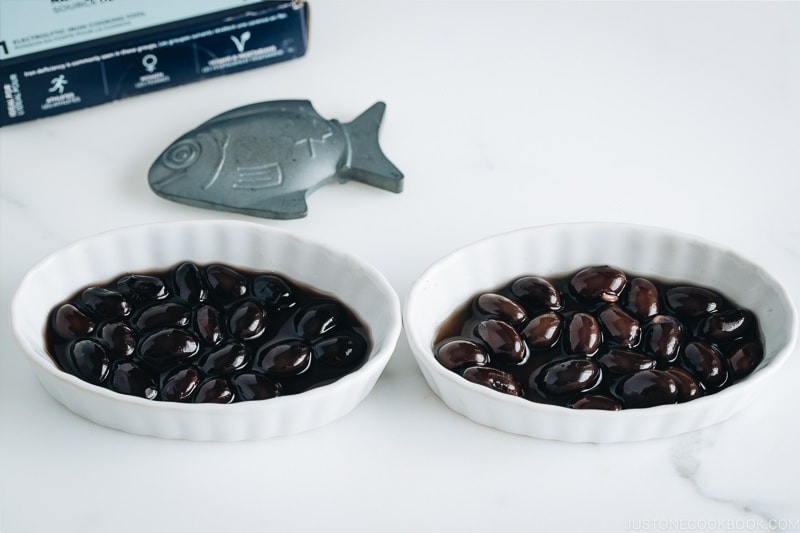
The result is pretty obvious. How about the taste? Whether you use the Lucky Iron Fish or not, they taste the same. What if you add the Lucky Iron Fish after cooking, does it become darker? No, it doesn’t become darker. It’s too late to rectify the color.
Now is it worth $30 for buying the lucky fish? It might be good for you if you…
- make kuromame every year for the Japanese New Year.
- need to impress your mother, mother-in-law, or Japanese guests who appreciate the beautiful black kuromame.
- have someone who lacks iron in their diet and takes a supplement. You can cook other food with iron fish.
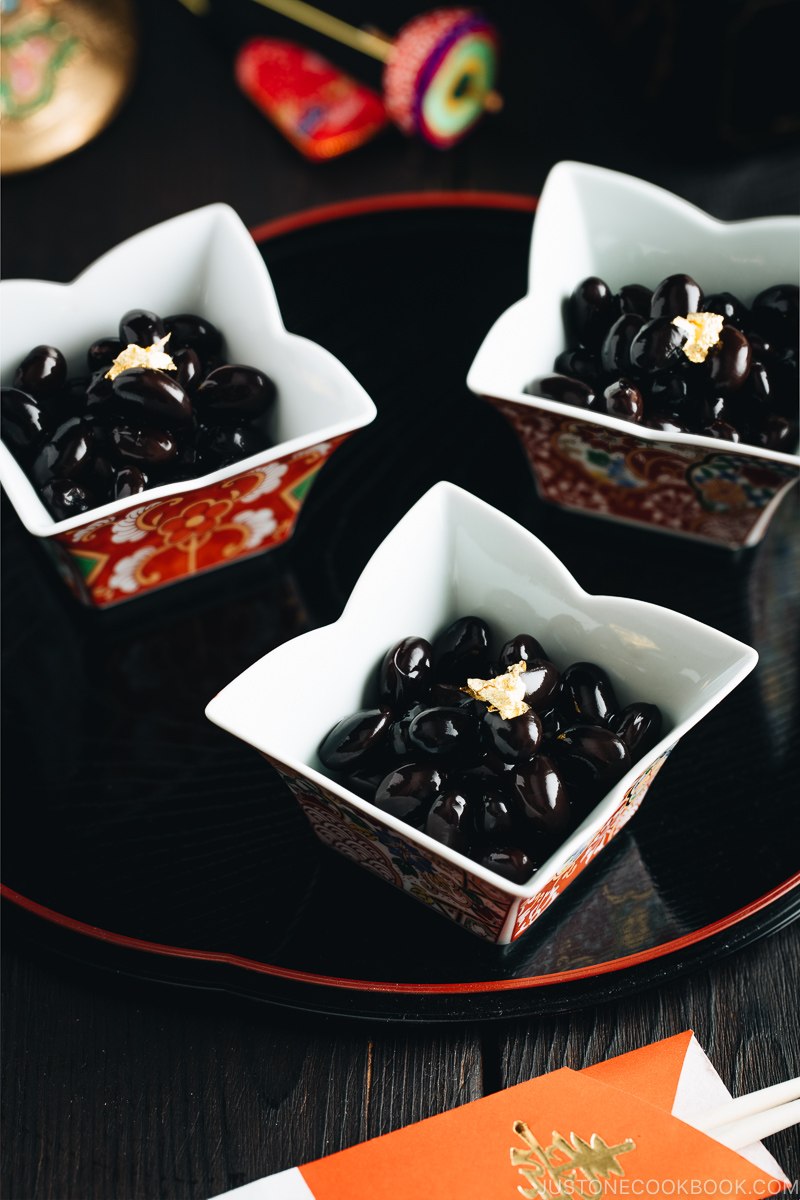
Don’t Have an Instant Pot or Pressure Cooker?
Don’t worry! I have the recipe for cooking kuromame in a pot on the stovetop. I learned that kuromame cooked on the stovetop with the iron fish actually has a richer color than kuromame cooked in the Instant Pot with the iron fish.
I hope you will include kuromame in your osechi menu. Here’s to good health and happiness!
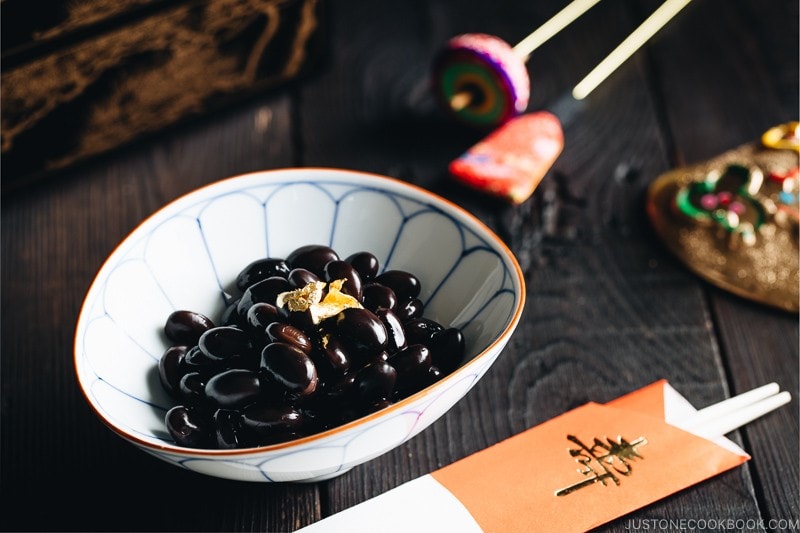
Wish to learn more about Japanese cooking? Sign up for our free newsletter to receive cooking tips & recipe updates! And stay in touch with me on Facebook, Pinterest, YouTube, and Instagram.
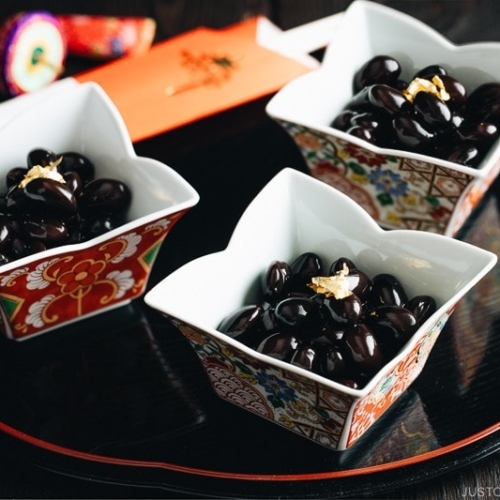
Instant Pot Kuromame
Video
Ingredients
- 8.8 oz kuromame (black soybeans) (dried)
- 4 cups water
- 1 cup sugar (7 oz; adjust the sweetness to your liking; typically, the ratio of black soybeans, sugar, and water is 1 to 1 to 6 by weight)
- 2½ tsp soy sauce
- ½ tsp Diamond Crystal kosher salt
For the Garnish
- edible gold leaf flakes (optional)
Instructions
Before You Start…
- Please note that this recipe requires a minimum soaking time of 4 hours for the dried beans; I also recommend a resting time of 8 hours once cooked, but this is not required. Please read and follow the package instructions for your black soybeans. My package directions say to soak for 4–5 hours, so I soaked them for 4 hours. For testing purposes, I tried soaking the same brand of soybeans overnight, and they came out a bit too soft. You may need to test to see how long you want to soak your soybeans.
- I recommend making this recipe 1–3 days before you plan to serve. For more helpful tips on planning your Japanese New Year feast, please read my A 5-Day Osechi Cooking Timeline blog post.
- Gather all the ingredients.

To Soak the Soybeans
- Gently rinse 8.8 oz kuromame (black soybeans) under cold running water. The skins are very fragile, so handle with care. Some beans have skin that is partially peeled off, but you can use those in this recipe. Discard any damaged soybeans. Drain well.

- Put the soybeans in the inner pot of an Instant Pot. Add 4 cups water to the pot. Depending on your package instructions, soak the soybeans for 4 hours or overnight on the counter in the wintertime (or in the refrigerator in the summertime and in warm climates).

- To enhance the color of the soybeans, we use rusty iron nails or Lucky Iron Fish to cook with the soybeans. (Read more in the blog post.) If you use rusty iron nails, clean 2–3 nails and wrap them in cheesecloth. Add the nails or the Iron Fish to the water with the soybeans.

To Cook
- After soaking, put the inner pot back into the Instant Pot (keep the nails or Iron Fish in the pot). Add 1 cup sugar, 2½ tsp soy sauce, and ½ tsp Diamond Crystal kosher salt. Mix gently.

- Close the lid and set to High pressure for 15 minutes (it will take 10 minutes to pressurize). Make sure the steam release handle points to Sealing and not Venting. The float valve will rise when pressurized.

- When it’s finished cooking, the Instant Pot will switch automatically to the Keep Warm mode. Let the pressure release naturally for about 45 minutes. Open the lid and check if the beans are done cooking; they should be tender enough to mash between two fingers. Then, take out the inner pot from the Instant Pot and remove the nails or Iron Fish.

- Pour the cooked soybeans and cooking liquid into a large airtight container. Leave uncovered and let the soybeans cool completely.

To Rest (recommended)
- Once cooled, the Kuromame are ready to eat. To yield a more striking black color and absorb more flavor, cover the container and let the soybeans soak in their cooking liquid for 8 hours or overnight in the refrigerator.

To Serve
- The following day, serve the Kuromame in a bowl without the cooking liquid. You can serve it either chilled or at room temperature. If you'd like to make it more festive, you can garnish it on top with edible gold leaf flakes (optional).

To Store
- Store the Kuromame in an airtight container, with enough cooking liquid to cover them, in the refrigerator for up to 4 days or in the freezer for one month.
To Use the Leftover Cooking Liquid and Kuromame
- You can use the leftover cooking liquid to make Oshiruko (Zenzai), black soybean latte, and jello (using gelatin, agar, or Kanten). You can use the leftover Kuromame to make pound cake and Steamed Cake.
Nutrition
Editor’s Note: This post was originally published on December 25, 2018. It’s been republished in December 2020.
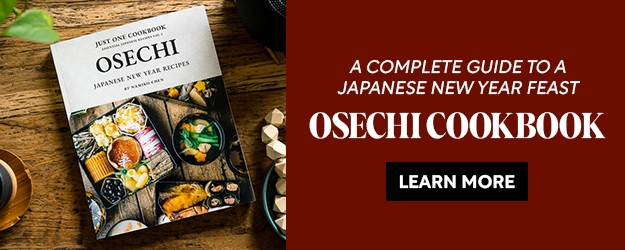
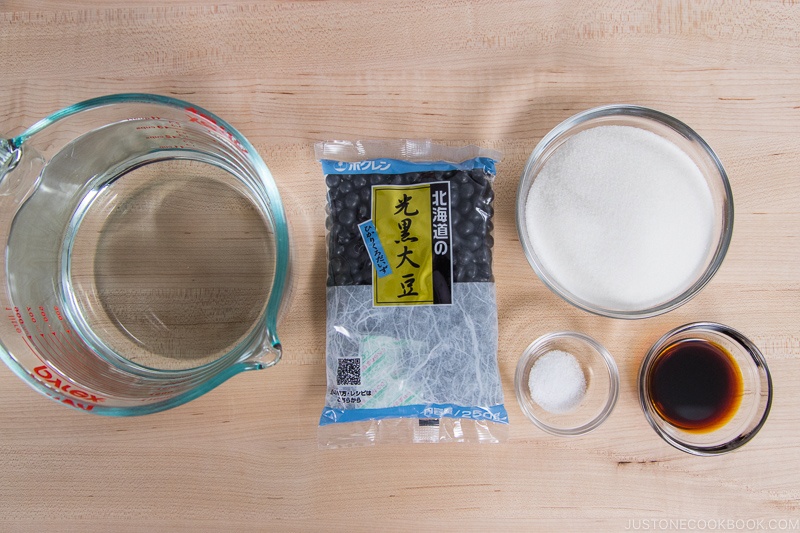
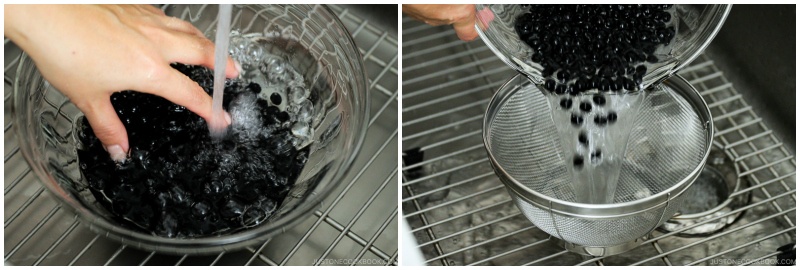
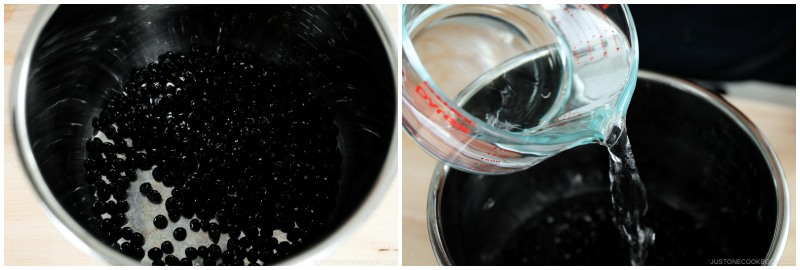
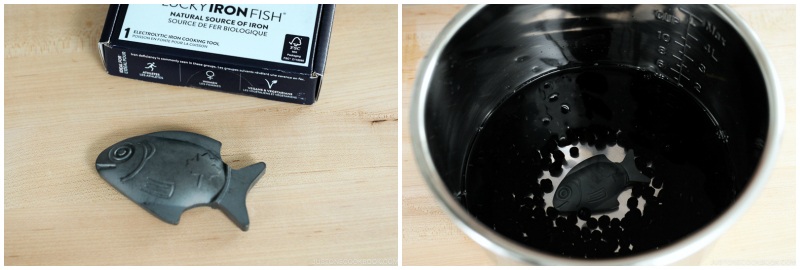

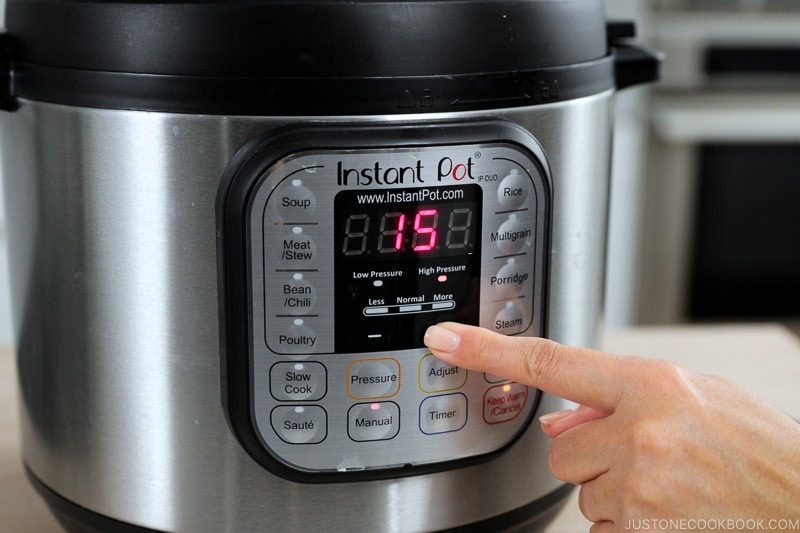
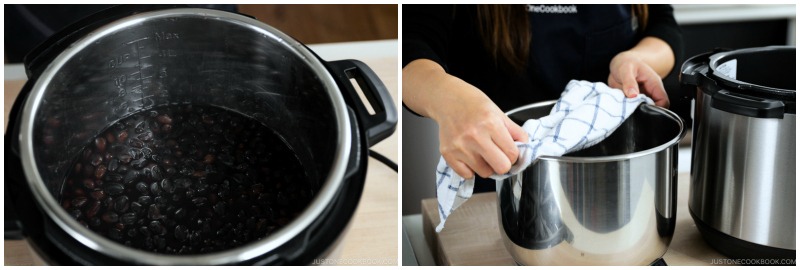
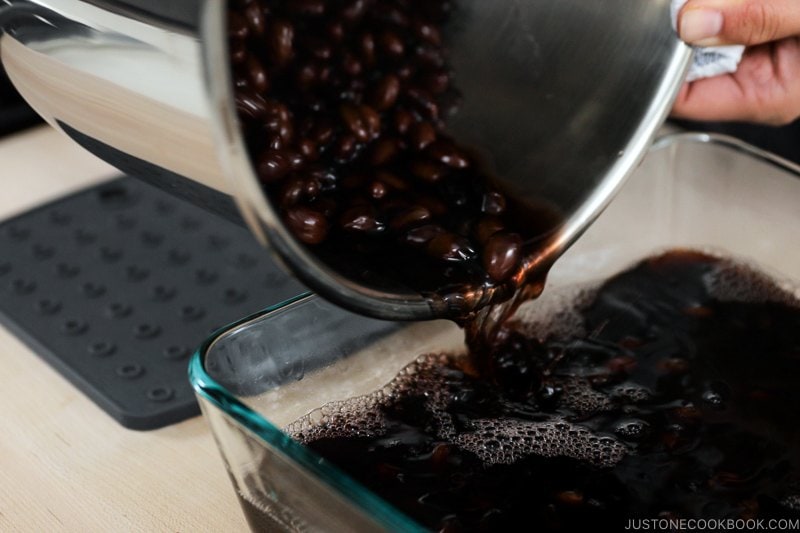
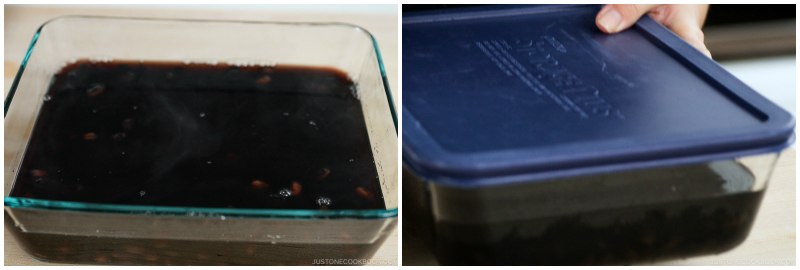











Hi Nami, Konichewa. Thank you for this recipe. My Okasan always made kuromame for New Years day. Now elderly, she doesn’t cook any more. I made this in my instant pot without the lucky iron fish. In an after thought, I remembered I had roasted chestnuts. I used the liquid & simmered the chestnuts & added it back to the mames. It was delicious & not too sweet. Also made simmered shrimp (excellent flavor), Tebashio (so easy & delicious) & Temaki . I’m learning a lot from you & you’re spot on ,Just One Cookbook is all I need. Thank you!
Hi Jam, Thank you very much for sharing your cooking experience with us! We are so glad to hear you enjoyed homemade Kuromame and many other dishes from our website. Thank you very much for trying Nami’s recipes and for your kind feedback.☺️
I’ve never made kuromame before since we usually just go to our relatives’ home for New Years. This year, due to the pandemic, we stayed home and I made kuromame for the first time. Thank you for the recipe and detailed instructions! My instant pot took about 45 minutes to release pressure but the beans still came out great and weren’t too soft.
Hi JD,
We are so happy to hear it turned out great, and you enjoyed the detailed instruction recipe!
Nami’s IP also takes about 45 minutes to release pressure, and she normally let it sit and preparing other dishes. We will add the information in the recipe card to let others know! Thank you!
Hi there– if I want to halve the recipe, how long should I cook it in the Instant Pot for?
Hi Naomi,
If you would like to halve the recipe, the cooking time will be slightly shorter, about 1~2 minutes.
We hope this helps!
Hi, Thank you so much for your recipes. I will be subscribing today.
By the way, how do you recommend cooking the Kuromane
without an instant pot? I would appreciate your advise.
Rebecca
Hi Rebecca! The regular pot recipe is here: https://www.justonecookbook.com/kuromame-sweet-black-soybeans/
My first and biggest problem was that the beans burst after soaking, becoming all checkered. As for iron, I give you a better idea: i dropped a sumpliment tablet of Iron 27 mg into the pot and it did wonders. The color is just classic.
Hi Olga! How did your black soybeans burst? Were the beans completely submerged? Over soaked? I have seen a few (maybe at most 2 soybeans) peel off its skin partially, but they were probably not the good batch (pre-soaked beans probably have scars etc). Do you think your black soybeans were bad batch? I would be so angry to see all the beans have no skin after soaking! Thank you for your tip on the supplement pill. 😀
[…] Black Beans (Kuromame) […]
If I want to add Konbu and waterchest nuts when should I add it to the kuromame?
Add before start pressure cooking. I’m not sure how the chestnut texture would be after cooking 15 minutes though…
I don’t have an instant pot and dont want to buy one….expensive….so how can I make this in my dutch oven…..”the old fashion slow cooking” method?
When we were in Japan we bought a little soy sauce pot made out of iron , in the shape of a tomato..it is bright red enamel on the outside. I left soy sauce in it and the inside rusted…could I put this little iron pot in with the soybeans instead of buying a fish? My mother in law in Japan just had some pieces of broken iron that she used when she made tsukemono in the rice bran.
Hi Bond! I have regular stovetop recipe here: https://www.justonecookbook.com/kuromame-sweet-black-soybeans/
If it’s made of 100% iron, I guess you can use it?
[…] Lucky Iron Fish: You can purchase it on Amazon. I also use 'Lucky Iron Fish' when I make Kuromame. […]
Thank you for posting the kuromame recipe! I will try it.
Would the lucky iron fish work for nasubi tsukemono too?
Kuulei
Hi Kuulei! YES! What a timing. I made tsukemono recipe (for the blog) yesterday and I did use the lucky iron fish for eggplant! 🙂
Hello, Nami.
Although I made kuromame on the stove, I did soak the beans for 4 hours with the Lucky Iron Fish. The beans still became purplish in color, not the nice black you show above. Do you have any suggestions?
Hi Ken! Did you leave at least overnight? You may see the actual color when I finish pressure cooking in the video or step by step pictures above. Do you see the beans are not fully dark yet? And now check out the beans after soaking overnight. See the difference? Much darker after soaking. Let’s say you’ve done this part already and still not dark enough. Question: 1) You used Japanese kuromame, right? 2) Did you use the soaking liquid to cook the beans as well?
Did I understand that we use the soaking liquid? Usually with bean soaking the rinse liquid is discarded but there wasn’t a new measurement or mention of fresh water. I am using the soaking liquid so hope it isn’t too hard to digest! I also reduced the sugar so hope it still works!
Hi Brenda! Yes, we use that black color soaking liquid – which is important to keep the beans darker in black. The traditional kuromame recipe uses the same weight for beans and sugar, but I’ve reduced quite a bit already. However, it’s up to you if you want to reduce even more. It’s supposed to be sweet taste, but I understand the amount of sugar is a bit scary. 🙂
Hi, Nami.
I made this today. The beans are tender, which is great. Can you tell me what the jelly white stuff you sometimes find in the beans. Is it konnyaku, if so, how do I sweeten it to induce with the kuromame?
Happy New Year.
Tim Inouye
Elk Grove, CA USA
Hi Timothy! Thank you for trying this recipe! The jelly white stuff in the beans? Do you mean you find it while cooking Kuromame? Konnyaku is an ingredient and it’s not something that appears by cooking Kuromame. I need a bit more information on what you meant. Kuromame should be just the beans and nothing else in there. Let me know or send me a picture if you have it. 🙂
[…] year. If you want to cut down on cooking time, you can use your a pressure cooker and follow this Instant Pot Kuromame […]
Thanks for posting this recipe – I am making it now. Do you know if the cook time changes if I make double the amount?
Hi Teri! I’m so sorry for my late response. No, the cooking time hould be same. Hope you enjoy(ed) the recipe!